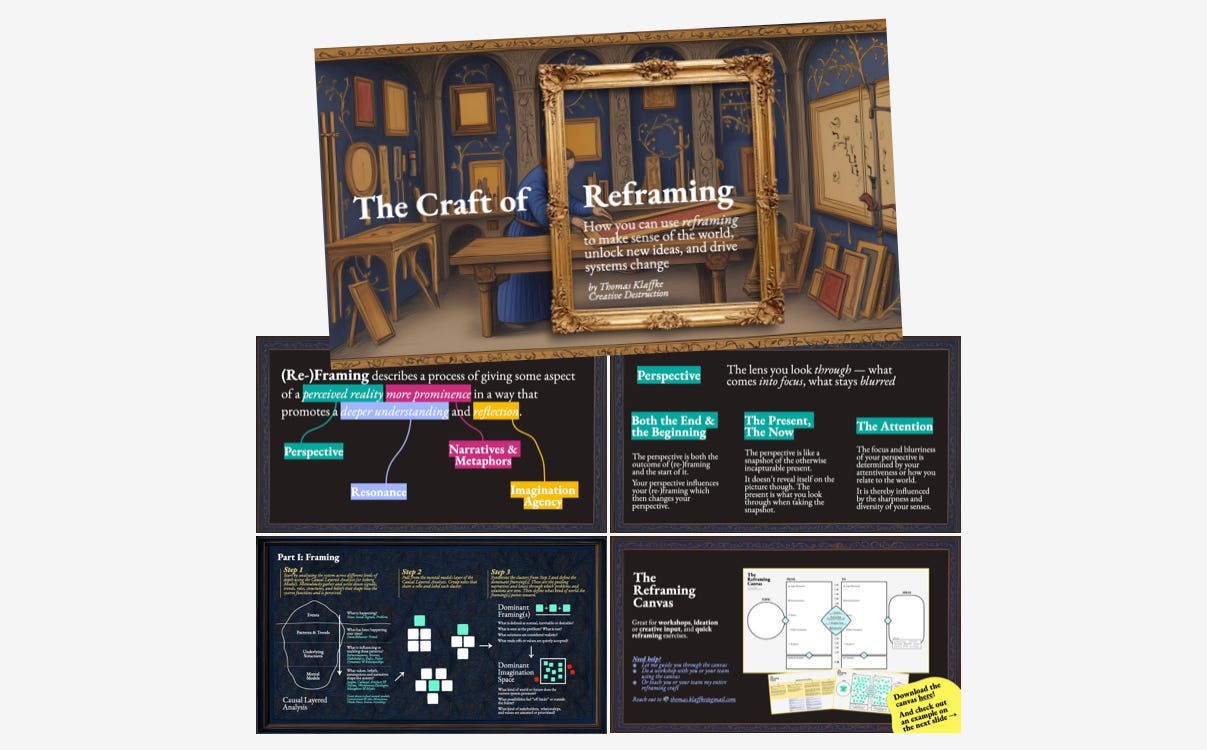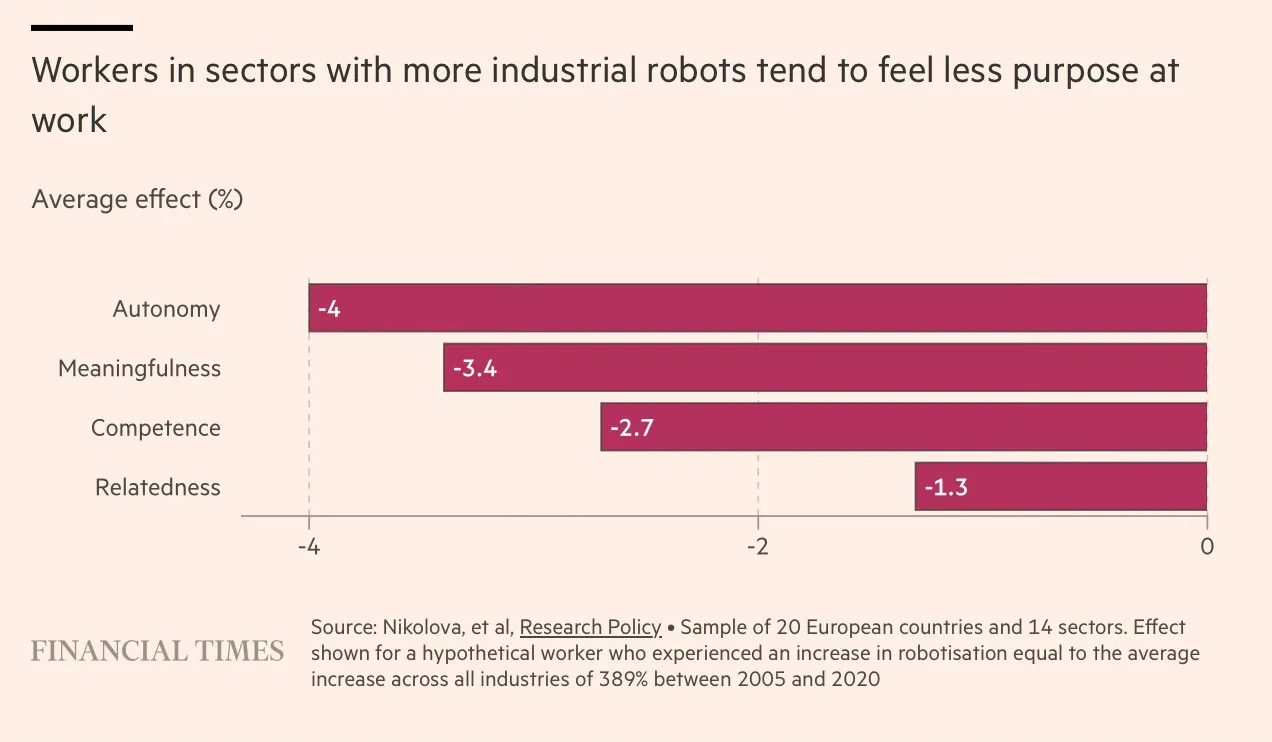Rabbit Holes 🕳️ #119
From collapse by a thousand optimizations to late cycle theory, GenAI as our polyester, narrative enactment, networking → contact, habits of a systems thinker and the third place zine
Hello and welcome to the 115 new subscribers who joined us since last week.
In case you missed it, last week I shared a deep dive into what I call my Craft of Reframing — an in-depth introduction to my reframing philosophy, technique (including a comprehensive step-by-step guide + a very actionable Reframing Canvas), and aesthetic. As you know, this newsletter is all about framings and reframings. The Craft of Reframing dives into the “how” of reframing, giving you all the theory and tools that you need to apply reframing in your work. Have a look:
And please do reach out if you want me to explain this method to you or your team, do a reframing workshop with you, or use my 10+ years of experience as a foresight researcher and systems thinker and apply this method to your challenge or project. (Yes, I am looking for freelance work 😅)
But now, without any further ado, on to this week’s Rabbit Holes:
THIS WEEK ↓
🖼️ Framings: Collapse By A Thousand Optimizations // Late Cycle Theory // GenAI Is Our Polyester
📊 Numbers: Robots vs. Soul-full Work
🌀 Re-Framings: Narrative Shift → Narrative Enactment // Networking → Contact // Transaction → Responsibility
🧬 Frameworks: Habits of a Systems Thinker
🎨 Works: Third Places Zine // Pedestrian-First Mapping // Photos From Inside Musical Instruments
⏳ Reading Time: 10 minutes🖼️ Framings
Naming Framing it! Giving something we all feel more prominence in a way that promotes a deeper reflection.
🧑💻 Collapse By A Thousand Optimizations
Not so sure about the remaining parts of this piece, but the abstract below hit the nail for me in terms of explaining how this AI-driven disruption is occurring and how it feels.
“It begins where it already has: the spreadsheet class. Knowledge workers, mid-tier specialists, operations staff, design generalists, customer service agents, administrators, analysts, and project managers—anyone whose job involves moving language or logic around inside a computer. That’s the target vector. Not because they’re expendable, but because they’re legible.
irst, the stack makes one talented human 10x more productive. That human now does the work of a team. This is praised. Headlines are written. Margins improve. Then someone asks why that one human is still on payroll when the workflow itself is automatable. The answer is silence. The next quarter, the answer is action.
Middle management will usher this in—not out of malice, but obedience. Because within their silo, their KPIs, their performance reviews, this will be rational. “We kept output high and costs low.” Never mind what it did to morale, institutional knowledge, long-term resilience, or local economies. Those aren’t their responsibilities. They report upward. And leadership? Leadership chases vibes. Efficiency. Innovation. “Strategic realignment.” All of it is downstream from shareholder logic.
This is how the middle class gets hollowed out—not by collapse, but by compliance. Payroll becomes a liability. AI becomes a line item. Jobs disappear without announcement. And workers, scared and exhausted, won’t fight back. They’ll quietly quit, quietly reapply, quietly break down. […]
None of this will look like a sci-fi apocalypse. It’ll look like another tool being adopted. Another budget adjustment. Another quiet month.
Collapse by a thousand optimizations.”
» Shit’s Gonna Get So Fucking Weird and Terrible by
🌗 Late Cycle Theory
In a long but extremely insightful, must-read essay, looks at today’s world through Carlota Perez’s late-cycle investment theory. Sounds abstract? Stay with me, because this stuff is some really out-there, thought-provoking macro shit about what may come next. The tl:dr? The next revolution is intelligent energy systems and will be driven by China.
“Viewing markets through Carlota's [late-cycle] theory suggests we're living through the 1970s of the age of computing and networks—not in mood, but in structure. […] According to Carlota's model, presented in Technological Revolutions and Financial Capital, each technological revolution follows a predictable arc: chaotic Installation, financial bubble, productive Deployment, and finally, a maturity phase. My view is that we've clearly moved into that final stage, where the fog of uncertainty has lifted. Optimisation, not disruption, becomes the focus.
Consider what the 1970s actually looked like. The dominant techno-economic paradigm then was oil, automobiles, and mass production. By that decade, we'd hit a wall. Mass production no longer delivered returns in key industries, and even Detroit's carmakers faced a destructive trade-off between costs and defects.
My analysis suggests COVID revealed a similar dynamic for computing and networks. We pushed every digital capability to its limits during lockdowns, only to discover not just software's boundaries but something more telling: when physical interaction became possible again, people rushed back to offices, restaurants, and concerts. Marc Andreessen's 2011 claim that “software is eating the world” seems to have run into hard limits—technical, yes, but also human. […]
Most tellingly, platform saturation now looks almost complete. Digital transformation has reached most sectors where computing and networks can plausibly work. What remains—healthcare delivery, education, construction, government services—may reflect the paradigm's natural limits, not untapped markets.”
» Late-Cycle Investment Theory by
👕 GenAI Is Our Polyester
W. David Marx compares GenAI art with polyester shirts, which initially (during the 1950s-60s) became very popular, replacing linen and cotton shirts due to their no-wrinkle, no-iron, wash-and-wear attributes. However, from the 1980s onwards, as David writes, “the connotation of polyester was no longer 'high-tech' but low-class. This class bias imbued polyester with a negative status value that made it ultimately look ugly.” May we see a similar development when it comes to GenAI art?
“Today manufacturers continue to use polyester-cotton blends to create “wrinkle-free” garments, but the stigmas remain. A “beautiful” shirt from a high-end brand comes in real cotton or linen, despite all the inefficiencies involved.
I rehash the rise and fall of polyester because I believe it presages what will happen to generative AI art. […] While polyester took a few decades to lose its appeal, GenAI is already feeling a bit cheesy. […]
Humans have no universal faculty to judge aesthetics: Our appreciation of beauty is highly-contextual and depends on factors other than the raw visual stimulus. Most tech-workers are unaware of this fact, and for them, the fact that AI-art resembles human-art means it must be pretty damn good. But AI art is already in very poor taste: not just because it recycles existing conventions in a way that looks outmoded, but because it's already overly associated with less-than-prestigious institutions. GenAI art has already reached polyester status, and this is just the beginning. Despite all the techno-utopian promises, our brains see it as ersatz. […]
Our era's particular neoliberal hyper-connected, hyper-capitalist economy is creating a lot of profit for a few people, but it’s absolutely devastating for the creation of deep meaning. […] AI is simply the latest step in this long process of devaluation — auguring a future where the entire fabric of our lives, from top to bottom, becomes polyester.
But the historical rejection of polyester gives me hope. […] The more that the economy embraces synthetic culture, the more we'll be primed for a revival of non-synthetic culture.”
» GenAI is Our Polyester by W. David Marx
📈 Numbers
A thought-provoking chart that perfectly captures a pivotal shift:
😟 Robots vs. Soul-full Work
Below the paywall: 3 thought-provoking re-framings, 1 handy framework, and 3 inspiring examples that help you reimagine and build systems that feel more alive. Used weekly by 150+ creatives, strategists, and system-shapers – aka my paid subscribers.






